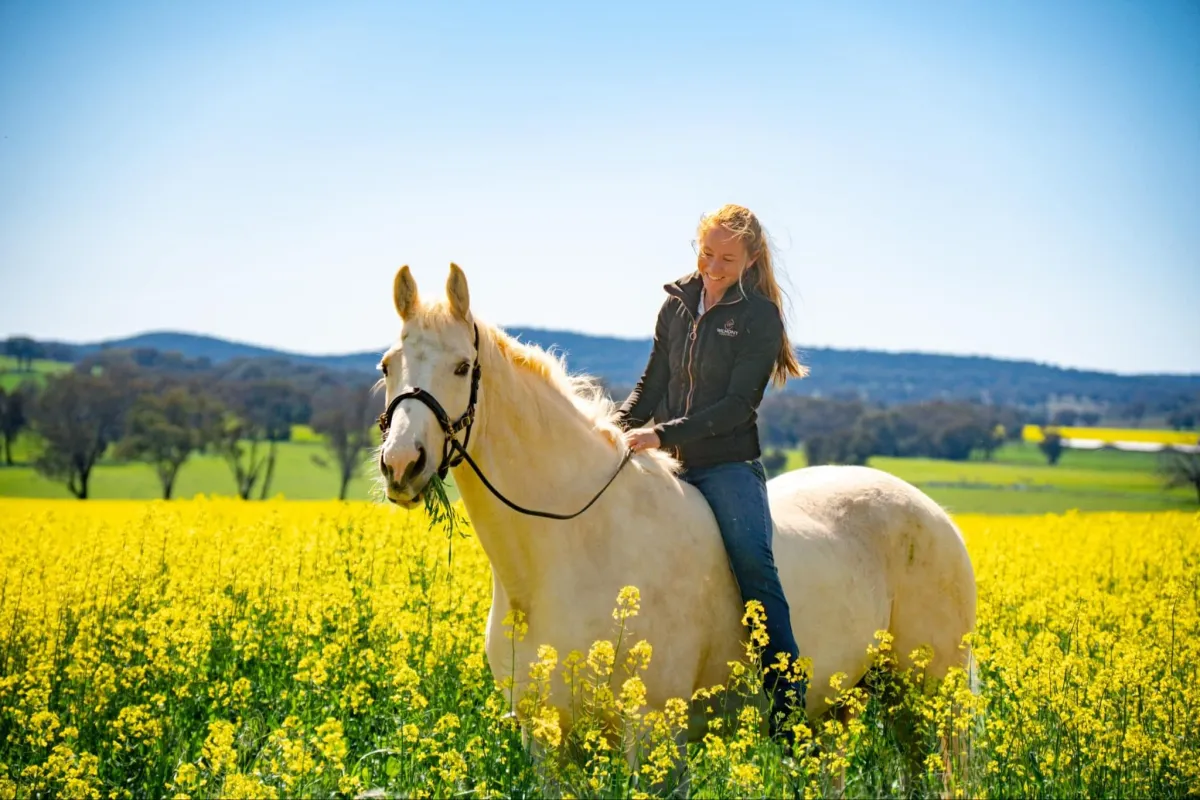
Honey
2016 WB/Arab x WB/Clydy mare
I first met Honey at the end of 2022 at a clinic in Albury. Honey was owned by a friend of mine who was also attending my Classical Dressage Clinic at that time. Honey’s owner was experiencing intermittent lameness issues with her. After multiple vet visits, x rays and investigation, the reasoning for her intermittent soundness issues was inconclusive.
In April of 2023 Honey was offered to me as a rehabilitation horse. I was excited at the opportunity and decided to take her on.
Honey had various physical issues. For the first few months, her rehabilitation mostly consisted of gentle massage and touch. I would start massaging Honey just behind her skullat C1 (Atlas) and work my way very slowly all the way to her tail on both sides. I would gently move the fascia between the skin and the muscle by placing a few fingers on Honey and moving my fingers gently in a circular motion. This is a really good exercise to be able to feel areas of your horse’s body which offer more and less mobility and also feel areas of injury such as small tears (which feel a bit like holes.)
In the beginning, Honey had a lot of small tears around C1 and C2 and the fascia around c6 and c7 offered very little movability. Honey had changes of the APJ (Articular Process Joint) in the base of her neck and we suspect the start of kissing spines. She was also lame on her right hind. She was extremely defensive of my touch around the base of her neck, around her scapular, along her back and around her pelvis. In areas of Honey’s body where there was a lot of restriction, the fascia between the skin and the muscle felt like it was super glued and offered barely any movability. Sometimes if I became too close, or I was not gentle enough around areas of restriction, Honey would become defensive.
Discomfort can be xpressed in various ways, such as, walking away, pushing me away or pinning her ears, swishing her tail, lifting a leg.
I feel it is really important to remember our horses are always communicating with us and often by the time they resort to “dangerous behaviour” they have already tried to subtly communicate many many times beforehand. As owners, and as our horses’ best friend, It is our job to learn to listen to these subtleties.
After a few months of mostly spending time with Honey and gentle massage I started working with her more in hand. Honey’s body was very compromised, so instead of riding her I would work her in-hand. In-hand work is beneficial for strengthening a horse, whether it be:
*Building a young horse's muscles correctly in hand before they are started under saddle. *Strengthening a horse’s body after a spell before you begin riding again
*Using in-hand work to rehabilitate a horse’s body after injury.
*Strengthing the bond and trust between horse and owner.
In the beginning I would walk with Honey, concentrating on helping her find a good posture. First in straight lines, then circles. From there we moved onto lateral work, like
shoulder in, travers, half pass and pirouettes - all in walk.
Honey’s body became stronger and stronger with more and more work. As she became stronger physically she also became more stable emotionally. When Honey first moved in with me she was extremely sensitive and spooky. The reason she was so fragile emotionally was because she was so compromised physically.
In October of 2023 I had my first ride on Honey after 5 months of in-hand rehabilitation. Our first ride together was fairly awful, to be honest! She would jack-up and refuse to go forward, pin her ears and kick out. Even though Honey was feeling so much better and looking so much better in her body, her reaction was so intense because her memories of her rides prior to her rehabilitation, were ones that she didn't remember in a positive way. She had negative memories of these rides not because of her old owner or anything her old owner did but because she felt so unstable, unconfident and vulnerable within her own body.
From October 2023 through until February of 2024, I continued in-hand work with Honey 3 or 4 days a week, for 15-20 minutes a session and with a ride once a week or so.
In February of 2024 Honey had her teeth done by a dental professional. She had huge ramps in her upper molars which were causing her jaw to be stuck in one position and not allowing it to slide forward, or move correctly.
A horse’s tongue is held in the mouth by the hyoid bones. These two little bones connect via various muscles all the way to the back leg. These muscles work together and create what is known as a muscle chain. This muscle chain that connects the horse’s tongue to the hind leg also means that when there is an issue in the mouth (e.g. bad teeth, or a rider who is very strong in the hand and hard on the bit) the horse’s movement is also affected. Compression on the tongue can restrict the ability of hind leg movement by around 50%. Thus, resolving the issues in Honey’s jaw enabled increased fluidity in her movement.
More recently in March 2023 I started riding Honey more regularly and also started half steps (the beginnings of piaffe) in-hand. T
he photos below of Honey show her progress over the past year.







